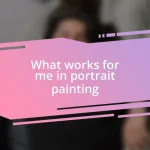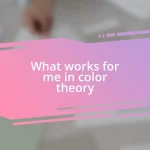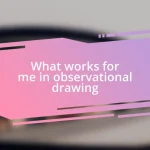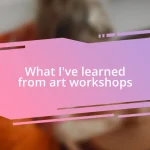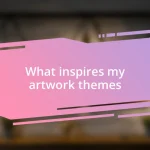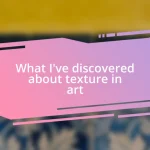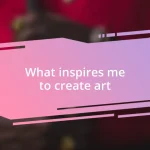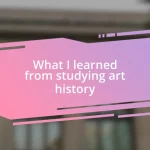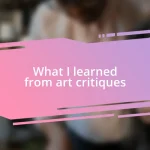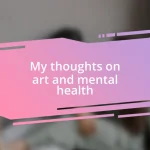Key takeaways:
- Art serves as a powerful medium to reflect and address social issues, sparking conversations and emotional connections through various techniques like mixed media, performance art, and digital storytelling.
- Collaborating with communities enhances the impact of art, allowing for authentic voices to be integrated and fostering solidarity and deeper understanding of social challenges.
- Engaging the audience effectively can be achieved through storytelling, humor, and interactive experiences, creating an environment where shared narratives promote empathy and action.

Understanding Art and Social Issues
Art has this incredible power to reflect and challenge social issues, doesn’t it? I remember visiting an exhibit that highlighted systemic inequalities through powerful visual narratives. It’s those moments when art makes you stop and think that can spark real conversations about change.
I often find myself drawn to street art, where the walls of a city pulse with voices that are sometimes overlooked. One piece I stumbled upon tackled mental health stigma in such a raw and vivid way that it felt like the artist was sharing their own story. It made me ponder: how often do we let our fears keep us silent instead of using our experiences to foster understanding?
Through my own artwork, I’ve explored themes like climate change and social justice, each brushstroke serving as a dialogue with the viewer. It’s astonishing how a single painting can evoke emotions and thoughts that resonate on a personal level. Have you ever felt that urge to express your thoughts but didn’t know how? That’s the beauty of art; it gives us a language to address the complexities of our society.

Choosing Relevant Social Issues
When it comes to selecting social issues to tackle through my art, I’ve learned that relevance is key. I often reflect on my own experiences and the world around me to inform my choices. For instance, during a community workshop on homelessness, I was struck by how many personal stories emerged, pushing me to create pieces that highlight this often-ignored struggle. Finding topics that resonate on both personal and societal levels not only fosters deep connections but also fuels the passion behind the creation.
- Reflect on personal experiences: Think about events or issues that have impacted your life directly.
- Listen to the community: Engage with local voices to uncover pressing concerns that need addressing.
- Stay informed: Follow current events and social movements to identify issues gaining traction and visibility.
- Consider emotional impact: Choose issues that evoke strong feelings, as this can enhance the emotional power of your artwork.
- Balance personal and universal themes: Find topics that are not only significant to you but also resonate with a broader audience.

Techniques for Artistic Expression
Artistic expression can take many forms, each with its own unique way of conveying messages and emotions. I’ve experimented with various techniques, but I always find mixed media particularly exciting. Combining paint, photography, and found objects can add layers of texture and meaning, creating a visual narrative that invites viewers to interact with the piece. It’s like weaving different threads of stories together, encouraging one to discover connections that might not be obvious at first glance.
Another technique I utilize is performance art, which allows me to physically embody the social issues I aim to address. I once participated in a live art installation that focused on the refugee experience. By portraying the challenges and resilience of those affected, it not only brought attention to the issue but also stirred deep emotions in the audience. When you’re moving through a space, embodying the message, it transforms the relationship between the art and the viewer into something more personal and immediate. Have you ever witnessed a performance that left you breathless? That’s the transformative power of performance art.
Digital storytelling is also an avenue I’ve explored; it merges technology with traditional artistic methods. I recall creating a short video piece that highlighted environmental concerns in my community. By blending visuals, sound, and narrative, I was able to reach a broader audience and spark discussions online that might not happen in a conventional gallery space. This technique not only broadens the scope of artistic expression but also makes impactful storytelling more accessible in today’s digital age.
| Technique | Description |
|---|---|
| Mixed Media | Combining various artistic elements to create depth and complexity. |
| Performance Art | Live presentations that embody social issues and evoke emotional connections. |
| Digital Storytelling | Using video and digital media to address topics and engage a wider audience. |

Collaborating with Communities
Collaborating with communities is a transformative experience for both the artists and the people involved. I remember facilitating an art workshop in a neighborhood grappling with high unemployment rates. We painted murals that reflected the aspirations and struggles of the community members. Seeing their faces light up with pride as they contributed to the artwork was a powerful reminder of how creativity can bring hope.
Listening is just as vital as creating when it comes to collaboration. During another project, I engaged with local youth to explore their views on social justice through art. Their raw insights were enlightening, revealing perspectives I hadn’t considered before. It made me realize: how often do we overlook the voices of those closest to the issues? By incorporating their narratives into my work, I elevated their stories and sparked conversations that mattered.
Art doesn’t exist in a vacuum, and partnerships can amplify its impact. I partnered with a community center to organize an exhibition highlighting domestic violence awareness. The stories shared by survivors were both heartbreaking and courageous. It struck me how collaboration not only creates art; it fosters a sense of community solidarity. Isn’t it inspiring how shared experiences can lead to more profound understanding and empathy?

Engaging the Audience Effectively
Engaging the audience effectively starts with understanding their perspectives and emotions. I recall a time when I hosted an interactive installation centered on mental health awareness. Instead of just displaying artwork, I invited attendees to share their thoughts and feelings, creating a conversation space. This interaction not only helped to normalize discussions around mental health but also allowed me to see how deeply the topic resonated with people. Can you imagine how powerful it is when art becomes a conduit for shared experiences?
Creating relatable narratives is another approach I’ve found to be impactful. While working on a project about homelessness, I shared stories of individuals I met on the streets. By framing their struggles in a personal light, I aimed to evoke empathy rather than pity. It’s astonishing how much a well-told story can open hearts. Have you ever felt the weight of someone else’s story resting on your shoulders? That’s what I strive for; making the audience feel the essence of the experiences I’m portraying.
Moreover, using humor can serve as a delightful bridge in addressing serious issues. Recently, I created a series of satirical illustrations critiquing societal norms surrounding body image. The laughter that ensued paved the way for deeper conversations, breaking down barriers that often keep people at a distance. Humor can be disarming; it invites us in without the heaviness that often accompanies discussions about challenging social issues. Isn’t it fascinating how a shared laugh can unite us in unexpected ways?

Measuring Impact of Art Projects
Measuring the impact of art projects involves examining both qualitative and quantitative outcomes. In one initiative focused on environmental awareness, we distributed surveys to participants after each event. The feedback was overwhelming—participants reported increased knowledge about sustainability and a desire to change their habits. It’s incredible to think that just by engaging with art, we can shift mindsets and evoke action!
I also explore impact by observing the emotional responses of participants. For instance, during a project aimed at addressing racial inequality, I noticed how attendees’ expressions changed as they participated in interactive pieces that reflected their experiences. Later, some participants approached me, sharing how the art made them feel seen and heard. Isn’t it fascinating how emotions can be such a powerful measure of success?
Social media has become a valuable tool for assessing impact, too. After hosting an exhibition on mental health, I was pleasantly surprised to see the conversations it sparked online. People shared their stories, tagged friends, and initiated discussions that continued long after the event. It’s rewarding to realize that the artwork transcended the gallery walls, creating a community dialogue. Who knew that a single art piece could grow into a movement just by connecting people in a shared space?

Sharing Your Art Journey
Sharing my art journey has been a transformative experience filled with moments of vulnerability and connection. I vividly recall my first solo exhibition, where I opened up about my struggles with anxiety through visual pieces. Seeing audience members approach me, sharing their own stories, was both humbling and uplifting. It made me realize how art can bridge gaps between strangers, sparking conversations that are often difficult to initiate. Have you ever found solace in someone else’s story?
As I reflect on my artistic path, I am struck by the importance of authenticity in sharing one’s journey. I remember a workshop I led, where participants were encouraged to create art that represented their personal challenges. Watching individuals embrace their stories through their creations was pure magic; it was as if the room filled with a sense of liberation. I find it so interesting how honoring your truth can inspire others to do the same. Isn’t it remarkable how art can serve as a mirror for both the creator and the observer?
Moreover, the digital realm has significantly enhanced how I share my artistic experiences. On platforms like Instagram, I regularly document my creative process, from brainstorming ideas to executing the final piece. One day, I posted a time-lapse of a mural I was painting, coupled with a caption about the importance of mental health. The response was overwhelming; comments flooded in from people expressing their gratitude for tackling such a poignant subject. It made me think: how often do we underestimate the ripple effect of sharing our journey? Each post could spark a dialogue, and that potential is exhilarating.
